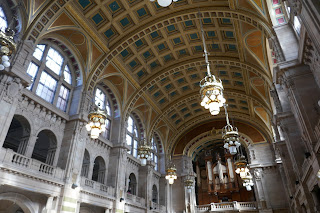On a flight from Frankfurt to Glasgow I got chatting to a 13-year-old Glaswegian, after he offered me a Tic-Tac, which I thought was charmingly polite. He had russet coloured hair, clear blue eyes and freckles and was one of the nicest people I’ve met for ages.
Which meant it came as a bit of a shock when he settled down to play a game called Plague Inc, the object of which he cheerfully explained to me was to infect the entire population of the world with mortal illnesses as quickly as possible. When I asked why the game makers didn’t design a game where you saved the world by rushing around preventing disease from spreading, my young friend's mother joined in the conversation. “Because they understand 13-year-old boys,” she said.
Anyway, when not playing his game or eating Tic-Tacs, my new friend gave me advice about what a visitor should do in Glasgow. This boiled down to going to Kelvingrove Gallery and, “if a miracle should happen and you actually see the sun during your stay”, going to the park beside it.
We dutifully followed his advice on our first morning. It wasn't difficult to do, as Kelvingrove is only a ten-minute stroll from where we are staying:
It is a hard building to fit into just one picture, but while flailing around trying to find a perspective where it might be possible I snapped this other rather nice building across from the gallery/museum:
And eventually I did get the whole gallery within my viewfinder, more or less, give or take bits of the backs of signs (isn’t it odd how often one can miss things within the frame until looking at the pictures later - or is that just me?)
Inside the gallery is magnificent.
The first things I saw that I liked were the handles on the entrance doors
and the doors themselves:
The doors led into a splendid hall. Sadly, it wasn’t possible to capture on camera, because they were so high up, but around the tops of the walls there are plaster or stone shields with the names of guilds carved into them, including the Skinners, the Fleshers and the Bonnetmakers, all trades that are pretty much gone now, I would guess:
I liked the carving of a boat on this pilaster at the far end of the entrance hall. The lettering also says something about trades, which is puzzling, as the building, according to my guide, was always intended as a gallery/museum:
In the first section of the museum I went into, much was made of a group of artists called the Glasgow Boys. The only painting of theirs that caught my eye was this one, painted in 1884 by Millie Dow (a man). It is called "The Hudson River" but the reason I noticed it is because it reminded me of paintings by the Australian impressionist Arthur Streeton:
There was a Charles Rennie Macintosh exhibition, which had just begun. While I knew Macintosh was an innovator, I had not realised until I read the curators' captions that the craftsmen of Vienna were inspired by Macintosh's designs - I’d always rather assumed that the Wiener Werkstatte came up with a number of things and Macintosh was inspired by them.
The most intriguing exhibit in this section, I thought, was Macintosh’s Domino Clock, which the caption says was made by interned German craftsmen on the Isle of Man in World War I. This led me to wondering what stories lie behind that statement - who were these Germans, where did they come from, how did they feel about being interned and about having to fulfil the orders of Charles Rennie Macintosh? Someone could probably write one of those slightly tedious novels that win the Booker, reimagining what went on, (there would be a lot of yearning):
On a purely personal mercenary level, I liked this belt buckle, which was made for Liberty by Jessie M King in 1901:
I also greatly coveted these handpainted glass objects, which were made in 1910 by Helen and Hannah Walton:

This one is called Interior with Card Players, and was painted by Joost van Geel in the 1660s and 1670s. According to the Kelvingrove, the people in this painting seem very elegant, but are probably a prostitute, the brothel madam, and their clients. Possibly there is a bit of Calvinist disapproval in some of the museum's captioning:
Excitingly, there was a Rembrandt, the first of his glowing helmet series, which up until now I'd only seen in a book my mother won as a prize at school:I was drawn to Vuillard's focus on textiles in this Woman in Blue with Child, painted in 1899:
Having been thwarted on the Macintosh House and Hungarian Gallery front, we all retired to the Hillhead Bookclub, which I highly recommend:



























I went to the gallery a couple of years ago and was very impressed. I also enjoyed the transport museum, which had an old Glaswegian train carriage, with lots of signs inside that read "No spitting".
ReplyDeleteI'd like to return to Glasgow when I don't have my sons with me - they were like a black cloud when we stayed there. I think they were in mourning for the Highlands.
Did they not even brighten up at the sight of the "No Spitting" signs? I think Glasgow has lots to explore, I was really surprised as had no real expectation
ReplyDeleteDid they not even brighten up at the sight of the "No Spitting" signs? I think Glasgow has lots to explore, I was really surprised as had no real expectation
ReplyDelete